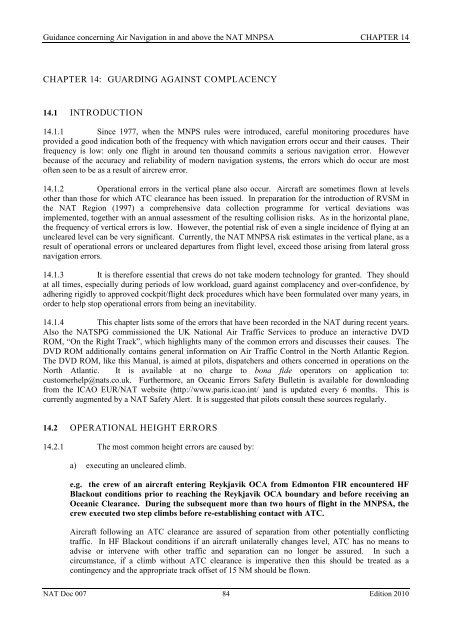World Air Ops | NAT | Doc 007 MNPS Guidance
World Air Ops | NAT | Doc 007 MNPS Guidance
World Air Ops | NAT | Doc 007 MNPS Guidance
You also want an ePaper? Increase the reach of your titles
YUMPU automatically turns print PDFs into web optimized ePapers that Google loves.
<strong>Guidance</strong> concerning <strong>Air</strong> Navigation in and above the <strong>NAT</strong> <strong>MNPS</strong>A CHAPTER 14CHAPTER 14: GUARDING AGAINST COMPLACENCY14.1 INTRODUCTION14.1.1 Since 1977, when the <strong>MNPS</strong> rules were introduced, careful monitoring procedures haveprovided a good indication both of the frequency with which navigation errors occur and their causes. Theirfrequency is low: only one flight in around ten thousand commits a serious navigation error. Howeverbecause of the accuracy and reliability of modern navigation systems, the errors which do occur are mostoften seen to be as a result of aircrew error.14.1.2 Operational errors in the vertical plane also occur. <strong>Air</strong>craft are sometimes flown at levelsother than those for which ATC clearance has been issued. In preparation for the introduction of RVSM inthe <strong>NAT</strong> Region (1997) a comprehensive data collection programme for vertical deviations wasimplemented, together with an annual assessment of the resulting collision risks. As in the horizontal plane,the frequency of vertical errors is low. However, the potential risk of even a single incidence of flying at anuncleared level can be very significant. Currently, the <strong>NAT</strong> <strong>MNPS</strong>A risk estimates in the vertical plane, as aresult of operational errors or uncleared departures from flight level, exceed those arising from lateral grossnavigation errors.14.1.3 It is therefore essential that crews do not take modern technology for granted. They shouldat all times, especially during periods of low workload, guard against complacency and over-confidence, byadhering rigidly to approved cockpit/flight deck procedures which have been formulated over many years, inorder to help stop operational errors from being an inevitability.14.1.4 This chapter lists some of the errors that have been recorded in the <strong>NAT</strong> during recent years.Also the <strong>NAT</strong>SPG commissioned the UK National <strong>Air</strong> Traffic Services to produce an interactive DVDROM, “On the Right Track”, which highlights many of the common errors and discusses their causes. TheDVD ROM additionally contains general information on <strong>Air</strong> Traffic Control in the North Atlantic Region.The DVD ROM, like this Manual, is aimed at pilots, dispatchers and others concerned in operations on theNorth Atlantic. It is available at no charge to bona fide operators on application to:customerhelp@nats.co.uk. Furthermore, an Oceanic Errors Safety Bulletin is available for downloadingfrom the ICAO EUR/<strong>NAT</strong> website (http://www.paris.icao.int/ )and is updated every 6 months. This iscurrently augmented by a <strong>NAT</strong> Safety Alert. It is suggested that pilots consult these sources regularly.14.2 OPERATIONAL HEIGHT ERRORS14.2.1 The most common height errors are caused by:a) executing an uncleared climb.e.g. the crew of an aircraft entering Reykjavik OCA from Edmonton FIR encountered HFBlackout conditions prior to reaching the Reykjavik OCA boundary and before receiving anOceanic Clearance. During the subsequent more than two hours of flight in the <strong>MNPS</strong>A, thecrew executed two step climbs before re-establishing contact with ATC.<strong>Air</strong>craft following an ATC clearance are assured of separation from other potentially conflictingtraffic. In HF Blackout conditions if an aircraft unilaterally changes level, ATC has no means toadvise or intervene with other traffic and separation can no longer be assured. In such acircumstance, if a climb without ATC clearance is imperative then this should be treated as acontingency and the appropriate track offset of 15 NM should be flown.<strong>NAT</strong> <strong>Doc</strong> <strong>007</strong> 84 Edition 2010
















